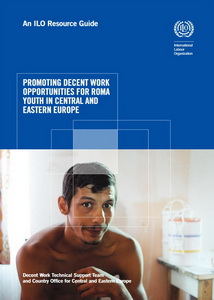 A new ILO Resource Guide on Promoting Decent Work Opportunities for Roma Youth in Central and Eastern Europe brings together good practices aimed at combating widespread institutional and labour market discrimination, as well as poverty amongst Roma.
A new ILO Resource Guide on Promoting Decent Work Opportunities for Roma Youth in Central and Eastern Europe brings together good practices aimed at combating widespread institutional and labour market discrimination, as well as poverty amongst Roma.
According to a 2011 EU survey, only one in three Roma is in paid employment, 9 in 10 live below the national poverty line, and approximately five in 10 reported experiencing discrimination as a result of their ethnicity. In addition, in contrast to the ageing European general population, the average age of the working population for Roma is 25, compared to the EU’s average of 40. Roma youth represent 10-20 per cent of new labour market entrants.
At the same time, only 15 per cent of the young Roma population has completed upper-secondary education and almost 60 per cent of those between 16 and 24 are not in employment, education or training.
“Roma young people are trapped in a vicious circle that leads them through high dropout rates in education, child labour, low skills acquisition, difficulty to access and to stay in the labour market, low pay, stereotyping and stigmatization that further push them to the margin of economic activities,” said Antonio Graziosi, Director of ILO Decent Work Technical Support Team and Country Office for Central and Eastern Europe.
“Promoting decent work for Roma, and non-Roma alike, and for specific groups among Roma youth such as women and girls or young people with disabilities, signals hope for a better future, breaking poverty cycles and avoiding squandering precious human capital,” he added.
Drawing on existing good practices, case studies and lessons learned, as well as ILO experiences, the Resource Guide addresses issues aimed at increasing the inclusion of Roma young people in the labour market. These include information on legal instruments and approaches to discrimination, social security and decent work, skills development and the school-to-work transition. It also highlights entrepreneurship promotion and the green economy, active labour market policies and employment services, as well as the role of social partners and social dialogue in tackling Roma youth unemployment.
The Roma population in Europe has been historically confronted with economic, social and cultural marginalization and discrimination. Many national and international programmes and actions have been implemented in Europe targeting the Roma community, particularly in the context of the Decade of Roma inclusion (2005-2015). On the basis of the feedback received by both Roma representatives and national and international partners, the results are mixed, however, with limited achievements especially in the field of employment.
The work of Roma photographers, Roland Bangó and Csaba Csóka, is featured in the Guide.
“I grew up in a small village called Szomolya. Born in a cave house, I spent my childhood without access to electricity, running water or other modern conveniences. My father died a long time ago, my mother had to bring up me and my three brothers alone,” Csóka said.
“As a child I wanted to become a football player, but because of a knee injury I had to give up this dream and become a mason in order to support my family. Later, I completed a four-year long high school programme in only three years and continued my education at Eger College to become a movie maker and director. I am the first – and up to now the only – degree holder in the history of my village.”
Bangó studied Communications and Media Studies at Peter Pázmány Catholic University. “For the past three and a half years, I have been working for the Chance for Children Foundation as a video maker and fieldworker,” he said. “I am the first in my family to complete higher education. My father has been doing hard physical work for 40 years, my mother is a housewife.”
Roma constitute Europe’s largest minority group estimated at around 10-12 million people. Although present in virtually every European country, the Roma are concentrated in Central and Eastern Europe – with over 3 million living in Romania, Bulgaria and Hungary alone – and in the Western Balkans they number as high as 600,000 in Serbia.
Source: www.ilo.org
 Government of the Republic of Serbia
Government of the Republic of Serbia















 pdf [271 KB]
pdf [271 KB]
Leave a Comment